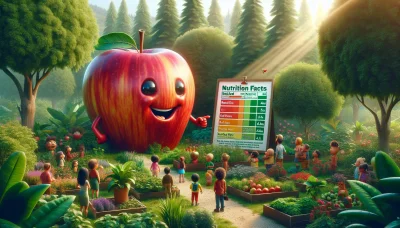Green apples benefits Quiz
Test Your Knowledge
Question of
The Surprising Benefits of Green Apples
Green apples are not only delicious but also packed with a variety of health benefits that may surprise you. They are a rich source of dietary fiber, which can help regulate your digestive system and contribute to weight loss by making you feel fuller for longer. Additionally, green apples contain a wealth of vitamins and minerals, including Vitamin C, which supports the immune system, and potassium, which can help manage blood pressure levels. Their high antioxidant content can also protect your cells from oxidative damage, potentially reducing the risk of chronic diseases. Moreover, the low calorie and high water content make them a perfect snack for those looking to maintain a healthy lifestyle. Incorporating green apples into your diet can be a tasty and effective way to boost your overall health.
Nutritional Value of Green Apples
| Nutrient | Amount per 100g |
|---|---|
| Dietary Fiber | 2.4g |
| Vitamin C | 4.6mg |
| Potassium | 107mg |
Green Apples in Gardening: What You Need to Know
Growing green apples in your garden is not only a delightful way to produce fresh fruit but also significantly benefits your garden's ecosystem. These trees can attract beneficial pollinators, such as bees and butterflies, which are essential for the pollination of many other plants in your garden. Additionally, the presence of green apple trees can help improve soil health through the natural decomposition of fallen leaves and fruit, which adds vital nutrients back into the soil. Moreover, they can serve as a natural windbreak and provide shade to more sensitive plants during the hot summer months. Incorporating green apple trees into your garden can create a more balanced and healthy ecosystem while offering the joy of harvesting your own fruit.
How to Grow Green Apple Trees
- Select a suitable variety of green apple tree that is known to thrive in your climate. Research the best types for your area.
- Purchase your green apple tree from a reputable nursery. Look for a healthy tree that is free from signs of pests and diseases.
- Choose a planting location that receives full sun for at least six hours a day and has well-draining soil. Avoid areas that are prone to flooding or standing water.
- Test your soil's pH to ensure it is between 6.0 and 7.0, which is ideal for apple trees. Amend your soil with lime or sulfur as needed to adjust the pH.
- Plant your tree in the early spring or late fall. Dig a hole that is twice as wide and just as deep as the root ball of your tree. Place the tree in the hole and backfill with soil, making sure the graft union (the bump near the base of the trunk) is above the soil line.
- Water your newly planted tree thoroughly. Continue to water it regularly, especially during dry spells, to keep the soil evenly moist but not waterlogged.
- Apply a layer of mulch around the base of the tree to help retain soil moisture and regulate soil temperature. Keep the mulch a few inches away from the trunk to prevent rot.
- Fertilize your green apple tree in the early spring before new growth begins. Use a balanced fertilizer or one that is specifically formulated for fruit trees.
- Prune your tree annually during the dormant season to remove any dead, damaged, or diseased branches and to shape the tree. Proper pruning will also encourage better air circulation and sunlight penetration, which can help reduce the risk of disease.
- Monitor for pests and diseases regularly. Treat any issues promptly with appropriate organic or chemical controls, following the recommendations for your specific problem and area.
- Be patient. It can take a few years for a new apple tree to begin producing fruit. Continue to care for your tree, and you will eventually enjoy a bountiful harvest of green apples.
Common Challenges in Growing Green Apples
Growing green apples can be a rewarding endeavor, but it comes with its share of challenges, particularly from pests and diseases. Common pests include apple maggots, codling moths, and aphids, each capable of causing significant damage to apple crops. Diseases like apple scab, fire blight, and powdery mildew also pose serious threats to green apple trees. To combat these issues, it's essential to adopt integrated pest management practices. This includes regular monitoring of trees for early signs of infestation, maintaining cleanliness around the orchard to minimize disease spread, and using resistant apple varieties when possible. Additionally, applying appropriate fungicides and insecticides, as needed, can help manage these problems effectively. However, it's crucial to use these chemicals responsibly to avoid harming beneficial insects and the environment.
Harvesting and Storing Your Green Apples
Best Practices for Harvesting Green Apples
- Check for ripeness. Green apples should be firm with a slight give when pressed. Look for a subtle color change from bright green to a slightly yellowish or creamy undertone.
- Test a few apples first. Before harvesting the entire crop, pick a few apples and taste them to ensure they're ripe.
- Use the proper technique. Gently twist the apple upwards and give it a slight pull. If ripe, it should easily come off the branch.
- Harvest in the morning. Cooler temperatures help in keeping the apples fresher during the picking process.
- Handle with care. Place apples gently into your collection basket or bin to avoid bruising.
Tips for Storing Green Apples
- Keep them cool. Store your apples in a cool, dark place. Ideally, they should be kept in a refrigerator in the crisper drawer.
- Store separately. Apples emit ethylene gas, which can cause other fruits and vegetables to ripen and spoil faster. Store them away from other produce.
- Wrap individually. If possible, wrap each apple in a damp paper towel and place it in a plastic bag. This helps to maintain moisture and keep the apples fresh longer.
- Check regularly. Inspect your stored apples regularly for any signs of spoilage or bruising and remove any affected apples to prevent further spoilage.
- Consider controlled atmosphere storage. For long-term storage, consider using controlled atmosphere storage if available. This method adjusts the oxygen, carbon dioxide, and humidity levels to prolong freshness.












